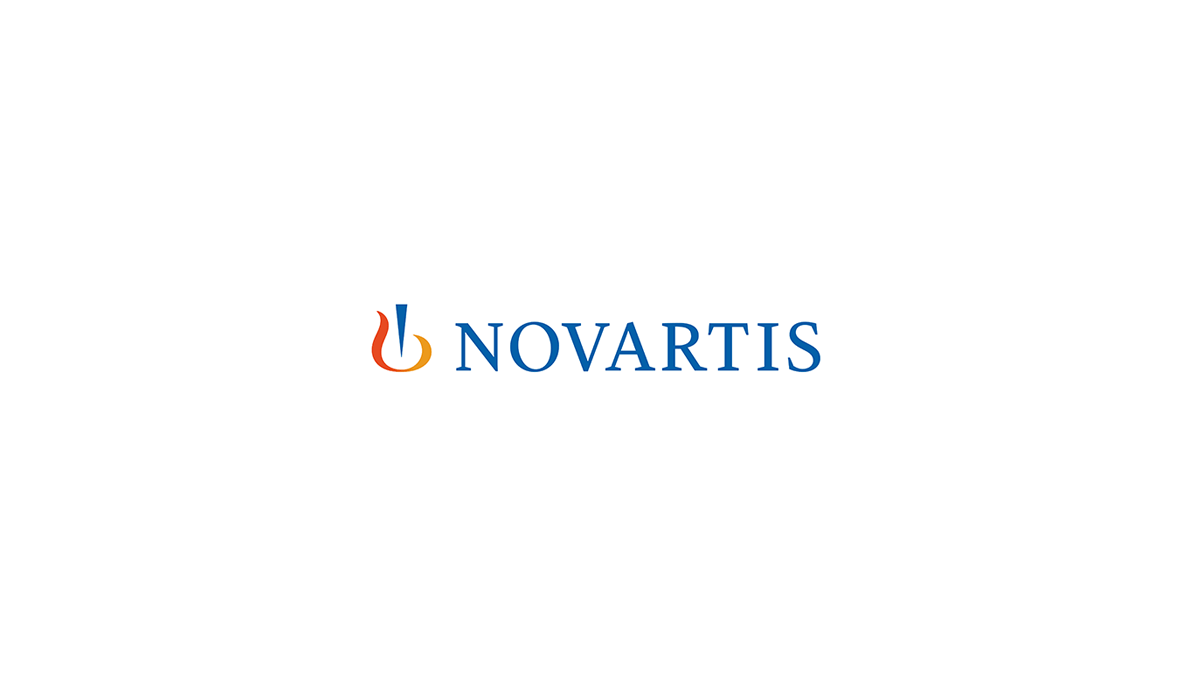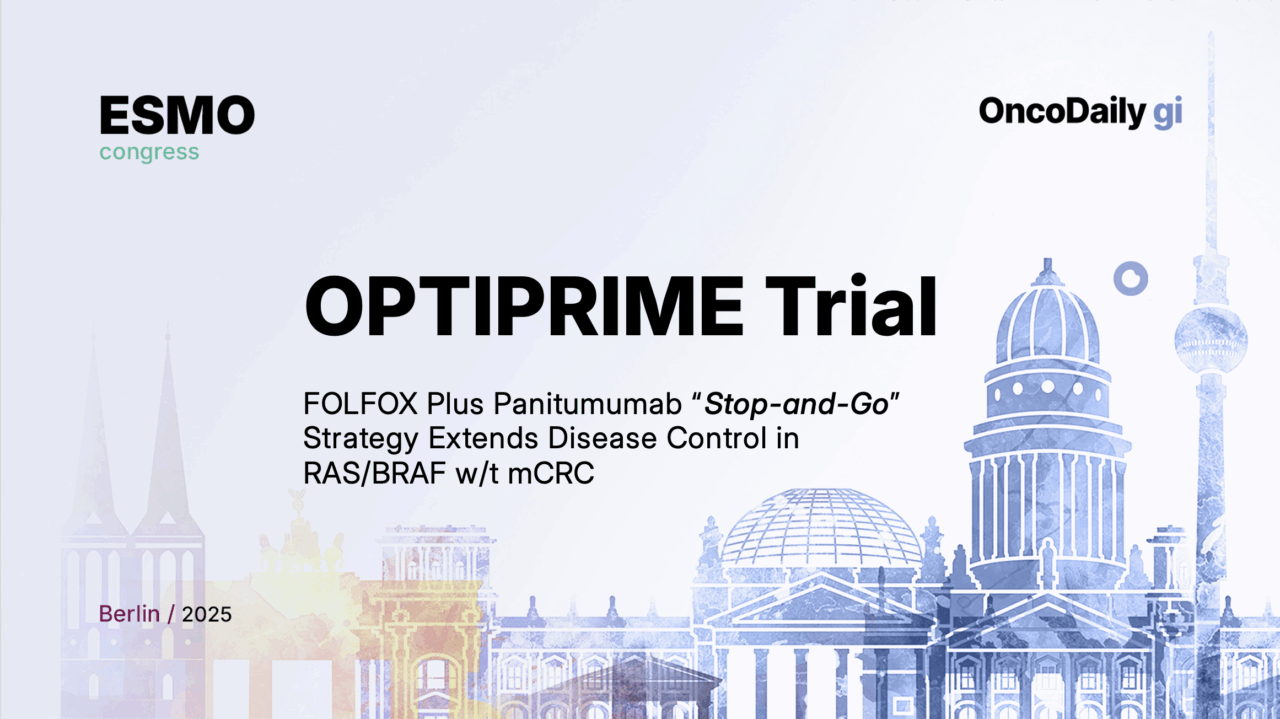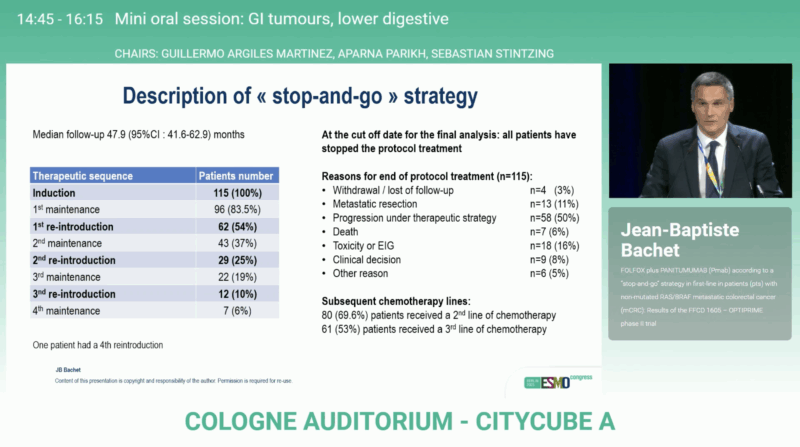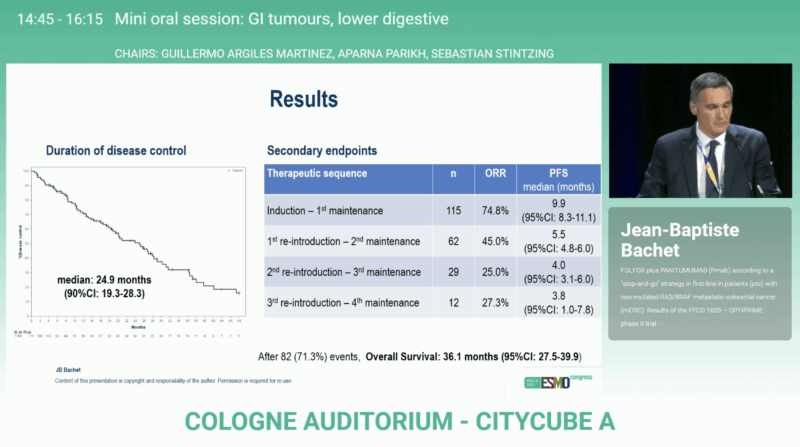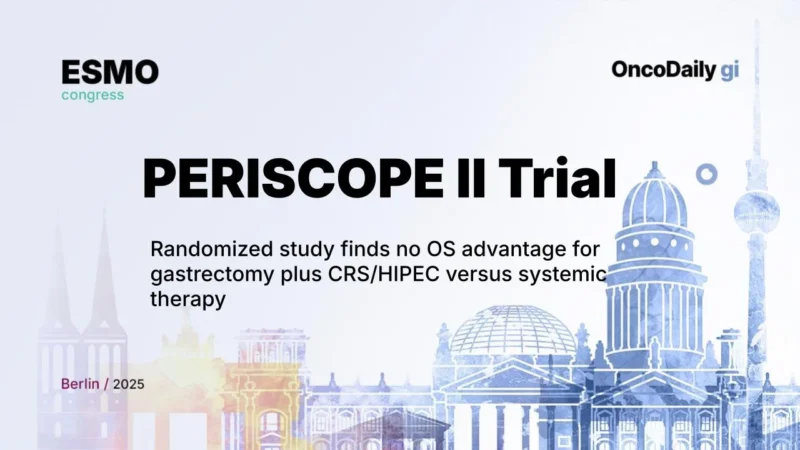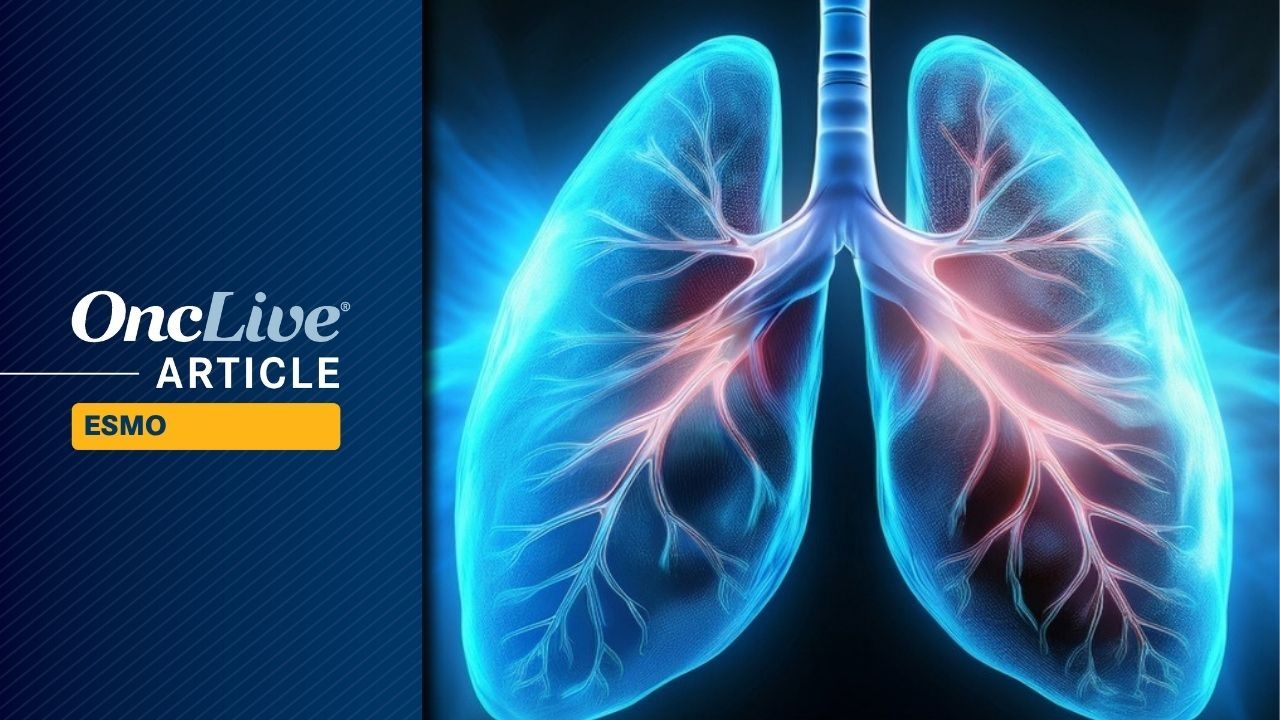Raritan, New Jersey, October 19, 2025 – Johnson & Johnson (NYSE:JNJ) today announced promising new results from the Phase 1b/2 OrigAMI-4 study evaluating the efficacy and safety of subcutaneous (SC) amivantamab monotherapy in patients with human papillomavirus (HPV)-unrelated, recurrent or metastatic head and neck squamous cell carcinoma (R/M HNSCC) after disease progression on a checkpoint inhibitor and platinum-based chemotherapy. The study used the new subcutaneous formulation of amivantamab, which can be delivered in a five-minute manual injection, offering increased patient convenience compared to intravenous RYBREVANT® (amivantamab-vmjw). Data were presented during a mini-oral session at the European Society for Medical Oncology (ESMO) 2025 Congress (Oral Abstract #1327MO).1
Patients with R/M HNSCC have limited options and poor outcomes after disease progression on a PD-1 or PD-L1 inhibitor and platinum-based chemotherapy.2 Many are unable to receive further treatment, and for those who do, response rates with available therapies are typically only 10 to 24 percent.2,3,4 Survival remains short, with a median of 6 to 9 months, and may be even shorter among patients with HPV-unrelated disease.2,4,5,6 Patients also face a significant burden of symptoms such as difficulty swallowing, impaired speech, pain and fatigue.2 Epidermal growth factor receptor (EGFR) and MET, two key tumor drivers, are overexpressed in 80 to 90 percent of HNSCC tumors, highlighting their role as potential treatment targets.7,8,9 RYBREVANT®, the world’s first bispecific antibody approved for lung cancer, inhibits EGFR and MET, in addition to activating the immune system to attack cancer cells.10
“Patients with recurrent or metastatic head and neck cancer face an aggressive disease that significantly impacts their quality of life,” said Professor Kevin Harrington*, MBBS, Ph.D., Professor in Biological Cancer Therapies at The Institute of Cancer Research, Royal Marsden Hospital, London, UK, and primary study investigator. “These results represent one of the most encouraging response rates we’ve seen in this difficult-to-treat setting, with durability that could meaningfully extend the time patients live without their disease progressing.”
In Cohort 1 of the OrigAMI-4 study, treatment with SC amivantamab resulted in an overall response rate (the primary endpoint) of 45 percent in 38 efficacy-evaluable patients with R/M HNSCC unrelated to HPV with disease progression on or after a PD-1 or PD-L1 checkpoint inhibitor and platinum-based chemotherapy (95 percent confidence interval [CI], 29-62).1 Responses occurred quickly, with a median time to first response of 6.4 weeks (range, 5.7-18.3), and were durable, with a median duration of response of 7.2 months (95 percent CI, 5.3-not estimable [NE]).1,11 Tumor shrinkage of target lesions was observed in 82 percent of patients after 8.3 months follow-up.1 Median progression-free survival was 6.8 months (95 percent CI, 4.2-9.0), while median overall survival had not yet been reached (95 percent CI, 7.7-NE).1
“These data highlight the broader potential of RYBREVANT-based therapies across solid tumors where the EGFR and/or MET pathways are activated,” said Kiran Patel, Vice President, Global Head, Solid Tumor Clinical Development and Diagnostics, Johnson & Johnson Innovative Medicine. “RYBREVANT combinations have already demonstrated significant results for certain patients with non-small cell lung cancer, leading to extended survival and delayed treatment resistance. Now we’re building on that progress in other hard-to-treat diseases like head and neck cancer. By targeting EGFR and MET while also engaging the immune system, subcutaneous amivantamab could provide new options for more patients who have few effective treatments.”
The safety-evaluable population included 86 patients who received at least one dose of SC amivantamab monotherapy. The safety profile was consistent with prior SC amivantamab monotherapy studies, with no new safety signals observed. The most common treatment-emergent adverse events were fatigue (31 percent), hypoalbuminemia (31 percent) and stomatitis (23 percent). Administration-related reactions occurred in seven percent of patients, all mild to moderate (grade 1-2), with no severe events. Treatment discontinuation due to treatment-related adverse events occurred in two percent of patients.1
Based on these results, Johnson & Johnson is initiating further study of SC amivantamab in head and neck cancer with the Phase 3 OrigAMI-5 study, which is evaluating first-line SC amivantamab with pembrolizumab and carboplatin versus 5-fluorouracil (5FU) plus pembrolizumab and platinum-based chemotherapy (cisplatin or carboplatin) in patients with HPV-unrelated R/M HNSCC. In addition to supporting further evaluation in first-line R/M HNSCC, these findings add to the evidence supporting the role of RYBREVANT®-based treatments across multiple solid tumors, including non-small cell lung cancer, colorectal cancer and HNSCC.
About the OrigAMI-4 Study
OrigAMI-4 (
NCT06385080) is an open-label Phase 1b/2 study evaluating SC amivantamab in recurrent or metastatic head and neck squamous cell carcinoma (R/M HNSCC). The study includes five cohorts, including Cohort 1, which studied SC amivantamab as monotherapy in patients with human papillomavirus (HPV)-unrelated R/M HNSCC who had received prior platinum-based chemotherapy and PD-1/PD-L1 immunotherapy. Patients with prior anti-EGFR therapy were excluded. Subcutaneous amivantamab was administered every three weeks (Q3W) at 2400 mg, or 3360 mg for patients weighing 80 kg or more. The primary endpoint is overall response rate (ORR), assessed by blinded independent central review (BICR) using RECIST v1.1**.12
About Head and Neck Squamous Cell Carcinoma
Head and neck squamous cell carcinoma (HNSCC) is the most common type of head and neck cancer, accounting for more than 90 percent of cases and approximately 4.5 percent of all cancers worldwide.13 It develops in the mucosal linings of the oral cavity, oropharynx, hypopharynx, and larynx.13 Major risk factors include tobacco and alcohol use, as well as infection with high-risk human papillomavirus (HPV).13 Around 75 percent of cases are HPV-negative, which is typically associated with a poorer prognosis and reduced response to treatment.13,14 Despite advances in surgery, radiation, chemotherapy, and immunotherapy, many patients are diagnosed at an advanced stage, and recurrent or metastatic HNSCC continues to carry a poor prognosis.2,7
About Subcutaneous Amivantamab
Subcutaneous amivantamab is an investigational fixed-dose combination of the bispecific antibody amivantamab and recombinant human hyaluronidase PH20 (rHuPH20), which is part of Halozyme’s ENHANZE® drug delivery technology. It targets EGFR and MET with immune cell-directing activity and is being developed to address tumors driven by activating and resistance EGFR mutations as well as MET alterations.
Subcutaneous amivantamab is being studied across multiple tumor types, including head and neck squamous cell carcinoma (HNSCC) and non-small cell lung cancer (NSCLC).
About RYBREVANT®
RYBREVANT® (amivantamab-vmjw), a fully-human bispecific antibody targeting EGFR and MET with immune cell-directing activity, is approved in the
U.S.,
Europe and other markets around the world as monotherapy for the treatment of adult patients with locally advanced or metastatic NSCLC with EGFR exon 20 insertion mutations, as detected by an FDA-approved test, whose disease has progressed on or after platinum-based chemotherapy.10
RYBREVANT® is approved in the
U.S.,
Europe and other markets around the world in combination with chemotherapy (carboplatin and pemetrexed) for the first-line treatment of adult patients with locally advanced or metastatic NSCLC with EGFR exon 20 insertion mutations, as detected by an FDA-approved test.
RYBREVANT® is approved in the
U.S.,
Europe and other markets around the world in combination with LAZCLUZE® (lazertinib) for the first-line treatment of adult patients with locally advanced or metastatic NSCLC with EGFR exon 19 deletions or exon 21 L858R substitution mutations, as detected by an FDA-approved test.
RYBREVANT® is approved in the
U.S.,
Europe and other markets around the world in combination with chemotherapy (carboplatin-pemetrexed) for the treatment of adult patients with locally advanced or metastatic NSCLC with EGFR exon 19 deletions or L858R substitution mutations, whose disease has progressed on or after treatment with an EGFR TKI.
Subcutaneous amivantamab is approved in
Europe in combination with LAZCLUZE® for the first-line treatment of adult patients with advanced NSCLC with EGFR exon 19 deletions or exon 21 L858R substitution mutations, and as a monotherapy for the treatment of adult patients with advanced NSCLC with activating EGFR exon 20 insertion mutations after failure of platinum-based therapy. A Biologics License Application (BLA) was submitted to the U.S. FDA for this indication.
The National Comprehensive Cancer Network® (NCCN®) Clinical Practice Guidelines in Oncology (NCCN Guidelines®) for NSCLC§ prefer next-generation sequencing–based strategies over polymerase chain reaction–based approaches for the detection of EGFR exon 20 insertion, exon 19 deletion and L858R variants. The NCCN Guidelines include:
- Amivantamab-vmjw (RYBREVANT®) plus lazertinib (LAZCLUZE®) as a Category 1 recommendation for first-line therapy in patients with locally advanced or metastatic NSCLC with EGFR exon 19 deletions or exon 21 L858R mutations.15 †‡
- Amivantamab-vmjw (RYBREVANT®) plus chemotherapy as a Category 1 recommendation for patients with locally advanced or metastatic NSCLC with EGFR exon 19 deletions or exon 21 L858R mutations who experienced disease progression after treatment with osimertinib.15 †‡
- Amivantamab-vmjw (RYBREVANT®) plus chemotherapy as a Category 1 recommendation for first-line therapy in treatment-naive patients with newly diagnosed advanced or metastatic EGFR exon 20 insertion mutation-positive advanced NSCLC. 15 †‡
- Amivantamab-vmjw (RYBREVANT®) as a Category 2A recommendation for patients that have progressed on or after platinum-based chemotherapy with or without an immunotherapy and have EGFR exon 20 insertion mutation-positive NSCLC. 15 †‡
In addition to the Phase 1b/2 OrigAMI-4 study, RYBREVANT® is being studied in multiple clinical trials, including:
- The Phase 3 MARIPOSA (
NCT04487080) study assessing RYBREVANT® in combination with LAZCLUZE® versus osimertinib and versus LAZCLUZE® alone in the first-line treatment of patients with locally advanced or metastatic NSCLC with EGFR ex19del or substitution mutations.16
- The Phase 3 MARIPOSA-2 (
NCT04988295) study assessing the efficacy of RYBREVANT® (with or without LAZCLUZE®) and carboplatin-pemetrexed versus carboplatin-pemetrexed alone in patients with locally advanced or metastatic NSCLC with EGFR exon 19 deletions or L858R substitution mutations after disease progression on or after osimertinib.17
- The Phase 3 PAPILLON (
NCT04538664) study assessing RYBREVANT® in combination with carboplatin-pemetrexed versus chemotherapy alone in the first-line treatment of patients with advanced or metastatic NSCLC with EGFR exon 20 insertion mutations.18
- The Phase 3 PALOMA-3 (
NCT05388669) study assessing LAZCLUZE® with subcutaneous (SC) amivantamab compared to RYBREVANT® in patients with EGFR-mutated advanced or metastatic NSCLC.19
- The Phase 2 PALOMA-2 (
NCT05498428) study assessing SC amivantamab in patients with advanced or metastatic solid tumors including EGFR-mutated NSCLC.20
- The Phase 1 PALOMA (
NCT04606381) study assessing the feasibility of SC amivantamab based on safety and pharmacokinetics and to determine a dose, dose regimen and formulation for SC amivantamab delivery.21
- The Phase 1 CHRYSALIS (
NCT02609776) study evaluating RYBREVANT® in patients with advanced NSCLC.22
- The Phase 1/1b CHRYSALIS-2 (
NCT04077463) study evaluating RYBREVANT® in combination with LAZCLUZE® and LAZCLUZE® as a monotherapy in patients with advanced NSCLC with EGFR mutations.23
- The Phase 1/2 METalmark (
NCT05488314) study assessing RYBREVANT® and capmatinib combination therapy in locally advanced or metastatic NSCLC.24
- The Phase 1/2 swalloWTail (
NCT06532032) study assessing RYBREVANT® and docetaxel combination therapy in patients with metastatic NSCLC.25
- The Phase 1/2 PolyDamas (
NCT05908734) study assessing RYBREVANT® and cetrelimab combination therapy in locally advanced or metastatic NSCLC.26
- The Phase 2 SKIPPirr study (
NCT05663866) exploring how to decrease the incidence and/or severity of first-dose infusion-related reactions with RYBREVANT® in combination with LAZCLUZE® in relapsed or refractory EGFR-mutated advanced or metastatic NSCLC.27
- The Phase 2 COPERNICUS (
NCT06667076) study combining developments in treatment administration and prophylactic supportive care in representative US patients with common EGFR-mutated NSCLC treated with SC amivantamab in combination with LAZCLUZE® or chemotherapy.28
- The Phase 2 COCOON (
NCT06120140) study assessing the effectiveness of a proactive dermatologic management regimen given with first-line RYBREVANT® and LAZCLUZE® in patients with EGFR-mutated advanced NSCLC.29
- The Phase 1b/2 OrigAMI-1 (
NCT05379595) study assessing RYBREVANT® monotherapy and in addition to standard-of-care chemotherapy in patients with advanced or metastatic colorectal cancer.30
The legal manufacturer for RYBREVANT® is Janssen Biotech, Inc.
For more information, visit:
https://www.RYBREVANT.com.
RYBREVANT® IMPORTANT SAFETY INFORMATION10
WARNINGS AND PRECAUTIONS
Infusion-Related Reactions
RYBREVANT® can cause infusion-related reactions (IRRs) including anaphylaxis; signs and symptoms of IRR include dyspnea, flushing, fever, chills, nausea, chest discomfort, hypotension, and vomiting. The median time to IRR onset is approximately 1 hour.
RYBREVANT® with LAZCLUZE®
In MARIPOSA (n=421), IRRs occurred in 63% of patients, including Grade 3 in 5% and Grade 4 in 1% of patients. IRR-related infusion modifications occurred in 54%, dose reduction in 0.7%, and permanent discontinuation of RYBREVANT® in 4.5% of patients.
RYBREVANT® with Carboplatin and Pemetrexed
Based on the pooled safety population (n=281), IRRs occurred in 50% of patients including Grade 3 (3.2%) adverse reactions. The incidence of infusion modifications was 46%, and 2.8% of patients permanently discontinued RYBREVANT® due to IRR.
RYBREVANT® as a Single Agent
In CHRYSALIS (n=302), IRRs occurred in 66% of patients. IRRs occurred in 65% of patients on Week 1 Day 1, 3.4% on Day 2 infusion, 0.4% with Week 2 infusion, and were cumulatively 1.1% with subsequent infusions. 97% were Grade 1-2, 2.2% were Grade 3, and 0.4% were Grade 4. The median time to onset was 1 hour (range 0.1 to 18 hours) after start of infusion. The incidence of infusion modifications was 62% and 1.3% of patients permanently discontinued RYBREVANT® due to IRRs.
Premedicate with antihistamines, antipyretics, and glucocorticoids and infuse RYBREVANT® as recommended. Administer RYBREVANT® via a peripheral line on Week 1 and Week 2 to reduce the risk of IRRs. Monitor patients for signs and symptoms of IRRs in a setting where cardiopulmonary resuscitation medication and equipment are available. Interrupt infusion if IRR is suspected. Reduce the infusion rate or permanently discontinue RYBREVANT® based on severity. If an anaphylactic reaction occurs, permanently discontinue RYBREVANT®.
Interstitial Lung Disease/Pneumonitis
RYBREVANT® can cause severe and fatal interstitial lung disease (ILD)/pneumonitis.
RYBREVANT® with LAZCLUZE®
In MARIPOSA, ILD/pneumonitis occurred in 3.1% of patients, including Grade 3 in 1.0% and Grade 4 in 0.2% of patients. There was one fatal case (0.2%) of ILD/pneumonitis and 2.9% of patients permanently discontinued RYBREVANT® and LAZCLUZE® due to ILD/pneumonitis.
RYBREVANT® with Carboplatin and Pemetrexed
Based on the pooled safety population, ILD/pneumonitis occurred in 2.1% of patients with 1.8% of patients experiencing Grade 3 ILD/pneumonitis. 2.1% discontinued RYBREVANT® due to ILD/pneumonitis.
RYBREVANT® as a Single Agent
In CHRYSALIS, ILD/pneumonitis occurred in 3.3% of patients, with 0.7% of patients experiencing Grade 3 ILD/pneumonitis. Three patients (1%) permanently discontinued RYBREVANT® due to ILD/pneumonitis.
Monitor patients for new or worsening symptoms indicative of ILD/pneumonitis (e.g., dyspnea, cough, fever). For patients receiving RYBREVANT® in combination with LAZCLUZE®, immediately withhold both drugs in patients with suspected ILD/pneumonitis and permanently discontinue if ILD/pneumonitis is confirmed. For patients receiving RYBREVANT® as a single agent or in combination with carboplatin and pemetrexed, immediately withhold RYBREVANT® in patients with suspected ILD/pneumonitis and permanently discontinue if ILD/pneumonitis is confirmed.
Venous Thromboembolic Events with Concomitant Use of RYBREVANT® and LAZCLUZE®
RYBREVANT® in combination with LAZCLUZE® can cause serious and fatal venous thromboembolic (VTE) events, including deep vein thrombosis and pulmonary embolism (PE). Most events occurred during the first four months of therapy.
In MARIPOSA, VTEs occurred in 36% of patients including Grade 3 in 10% and Grade 4 in 0.5% of patients. On-study VTEs occurred in 1.2% of patients (n=5) while receiving anticoagulation therapy. There were two fatal cases of VTE (0.5%), 9% of patients had VTE leading to dose interruptions of RYBREVANT®, and 7% of patients had VTE leading to dose interruptions of LAZCLUZE®; 1% of patients had VTE leading to dose reductions of RYBREVANT®, and 0.5% of patients had VTE leading to dose reductions of LAZCLUZE®; 3.1% of patients had VTE leading to permanent discontinuation of RYBREVANT®, and 1.9% of patients had VTE leading to permanent discontinuation of LAZCLUZE®. The median time to onset of VTEs was 84 days (range: 6 to 777).
Administer prophylactic anticoagulation for the first four months of treatment. The use of Vitamin K antagonists is not recommended. Monitor for signs and symptoms of VTE events and treat as medically appropriate.
Withhold RYBREVANT® and LAZCLUZE® based on severity. Once anticoagulant treatment has been initiated, resume RYBREVANT® and LAZCLUZE® at the same dose level at the discretion of the healthcare provider. In the event of VTE recurrence despite therapeutic anticoagulation, permanently discontinue RYBREVANT® and continue treatment with LAZCLUZE® at the same dose level at the discretion of the healthcare provider.
Dermatologic Adverse Reactions
RYBREVANT® can cause severe rash including toxic epidermal necrolysis (TEN), dermatitis acneiform, pruritus, and dry skin.
RYBREVANT® with LAZCLUZE®
In MARIPOSA, rash occurred in 86% of patients, including Grade 3 in 26% of patients. The median time to onset of rash was 14 days (range: 1 to 556 days). Rash leading to dose interruptions occurred in 37% of patients for RYBREVANT® and 30% for LAZCLUZE®, rash leading to dose reductions occurred in 23% of patients for RYBREVANT® and 19% for LAZCLUZE®, and rash leading to permanent discontinuation occurred in 5% of patients for RYBREVANT® and 1.7% for LAZCLUZE®.
RYBREVANT® with Carboplatin and Pemetrexed
Based on the pooled safety population, rash occurred in 82% of patients, including Grade 3 (15%) adverse reactions. Rash leading to dose reductions occurred in 14% of patients, and 2.5% permanently discontinued RYBREVANT® and 3.1% discontinued pemetrexed.
RYBREVANT® as a Single Agent
In CHRYSALIS, rash occurred in 74% of patients, including Grade 3 in 3.3% of patients. The median time to onset of rash was 14 days (range: 1 to 276 days). Rash leading to dose reduction occurred in 5% and permanent discontinuation due to rash occurred in 0.7% of patients.
Toxic epidermal necrolysis occurred in one patient (0.3%).
Instruct patients to limit sun exposure during and for 2 months after treatment with RYBREVANT® or LAZCLUZE® in combination with RYBREVANT®. Advise patients to wear protective clothing and use broad-spectrum UVA/UVB sunscreen. Alcohol-free (e.g., isopropanol-free, ethanol-free) emollient cream is recommended for dry skin.
When initiating treatment, administer alcohol-free emollient cream to reduce the risk of dermatologic adverse reactions. Consider prophylactic measures (eg, use of oral antibiotics). If skin reactions develop, start topical corticosteroids and topical and/or oral antibiotics. For Grade 3 reactions, add oral steroids and consider dermatologic consultation. Promptly refer patients presenting with severe rash, atypical appearance or distribution, or lack of improvement within 2 weeks to a dermatologist. For patients receiving RYBREVANT® in combination with LAZCLUZE®, withhold, reduce the dose, or permanently discontinue both drugs based on severity. For patients receiving RYBREVANT® as a single agent or in combination with carboplatin and pemetrexed, withhold, dose reduce or permanently discontinue RYBREVANT® based on severity.
Ocular Toxicity
RYBREVANT® can cause ocular toxicity including keratitis, blepharitis, dry eye symptoms, conjunctival redness, blurred vision, visual impairment, ocular itching, eye pruritus, and uveitis.
RYBREVANT® with LAZCLUZE®
In MARIPOSA, ocular toxicity occurred in 16%, including Grade 3 or 4 ocular toxicity in 0.7% of patients. Withhold, reduce the dose, or permanently discontinue RYBREVANT® and continue LAZCLUZE® based on severity.
RYBREVANT® with Carboplatin and Pemetrexed
Based on the pooled safety population, ocular toxicity occurred in 16% of patients. All events were Grade 1 or 2.
RYBREVANT® as a Single Agent
In CHRYSALIS, keratitis occurred in 0.7% and uveitis occurred in 0.3% of patients. All events were Grade 1-2.
Promptly refer patients with new or worsening eye symptoms to an ophthalmologist. Withhold, reduce the dose, or permanently discontinue RYBREVANT® based on severity.
Embryo-Fetal Toxicity
Based on animal models, RYBREVANT® and LAZCLUZE® can cause fetal harm when administered to a pregnant woman. Advise females of reproductive potential of the potential risk to the fetus.
Advise patients of reproductive potential to use effective contraception during treatment and for 3 months after the last dose of RYBREVANT®, and for 3 weeks after the last dose of LAZCLUZE®.
ADVERSE REACTIONS
RYBREVANT® with LAZCLUZE®
In MARIPOSA (n=421) , the most common adverse reactions (ARs) (≥20%) were rash (86%), nail toxicity (71%), infusion-related reactions (IRRs) (RYBREVANT®) (63%), musculoskeletal pain (47%), stomatitis (43%), edema (43%), VTE (36%), paresthesia (35%), fatigue (32%), diarrhea (31%), constipation (29%), COVID-19 (26%), hemorrhage (25%), dry skin (25%), decreased appetite (24%), pruritus (24%), and nausea (21%). The most common Grade 3 or 4 laboratory abnormalities (≥2%) were decreased albumin (8%), decreased sodium (7%), increased ALT (7%), decreased potassium (5%), decreased hemoglobin (3.8%), increased AST (3.8%), increased GGT (2.6%), and increased magnesium (2.6%).
Serious ARs occurred in 49% of patients, with those occurring in ≥2% of patients including VTE (11%), pneumonia (4%), ILD/pneumonitis and rash (2.9% each), COVID-19 (2.4%), and pleural effusion and IRRs (RYBREVANT®) (2.1% each). Fatal ARs occurred in 7% of patients due to death not otherwise specified (1.2%); sepsis and respiratory failure (1% each); pneumonia, myocardial infarction, and sudden death (0.7% each); cerebral infarction, pulmonary embolism (PE), and COVID-19 infection (0.5% each); and ILD/pneumonitis, acute respiratory distress syndrome (ARDS), and cardiopulmonary arrest (0.2% each).
RYBREVANT® with Carboplatin and Pemetrexed
In MARIPOSA-2 (n=130), the most common ARs (≥20%) were rash (72%), IRRs (59%), fatigue (51%), nail toxicity (45%), nausea (45%), constipation (39%), edema (36%), stomatitis (35%), decreased appetite (31%), musculoskeletal pain (30%), vomiting (25%), and COVID-19 (21%). The most common Grade 3 to 4 laboratory abnormalities (≥2%) were decreased neutrophils (49%), decreased white blood cells (42%), decreased lymphocytes (28%), decreased platelets (17%), decreased hemoglobin (12%), decreased potassium (11%), decreased sodium (11%), increased alanine aminotransferase (3.9%), decreased albumin (3.8%), and increased gamma-glutamyl transferase (3.1%).
In MARIPOSA-2, serious ARs occurred in 32% of patients, with those occurring in >2% of patients including dyspnea (3.1%), thrombocytopenia (3.1%), sepsis (2.3%), and PE (2.3%). Fatal ARs occurred in 2.3% of patients; these included respiratory failure, sepsis, and ventricular fibrillation (0.8% each).
In PAPILLON (n=151), the most common ARs (≥20%) were rash (90%), nail toxicity (62%), stomatitis (43%), IRRs (42%), fatigue (42%), edema (40%), constipation (40%), decreased appetite (36%), nausea (36%), COVID-19 (24%), diarrhea (21%), and vomiting (21%). The most common Grade 3 to 4 laboratory abnormalities (≥2%) were decreased albumin (7%), increased alanine aminotransferase (4%), increased gamma-glutamyl transferase (4%), decreased sodium (7%), decreased potassium (11%), decreased magnesium (2%), and decreases in white blood cells (17%), hemoglobin (11%), neutrophils (36%), platelets (10%), and lymphocytes (11%).
In PAPILLON, serious ARs occurred in 37% of patients, with those occurring in ≥2% of patients including rash, pneumonia, ILD, PE, vomiting, and COVID-19. Fatal adverse reactions occurred in 7 patients (4.6%) due to pneumonia, cerebrovascular accident, cardio-respiratory arrest, COVID-19, sepsis, and death not otherwise specified.
RYBREVANT® as a Single Agent
In CHRYSALIS (n=129), the most common ARs (≥20%) were rash (84%), IRR (64%), paronychia (50%), musculoskeletal pain (47%), dyspnea (37%), nausea (36%), fatigue (33%), edema (27%), stomatitis (26%), cough (25%), constipation (23%), and vomiting (22%). The most common Grade 3 to 4 laboratory abnormalities (≥2%) were decreased lymphocytes (8%), decreased albumin (8%), decreased phosphate (8%), decreased potassium (6%), increased alkaline phosphatase (4.8%), increased glucose (4%), increased gamma-glutamyl transferase (4%), and decreased sodium (4%).
Serious ARs occurred in 30% of patients, with those occurring in ≥2% of patients including PE, pneumonitis/ILD, dyspnea, musculoskeletal pain, pneumonia, and muscular weakness. Fatal adverse reactions occurred in 2 patients (1.5%) due to pneumonia and 1 patient (0.8%) due to sudden death.
LAZCLUZE® Drug Interactions
Avoid concomitant use of LAZCLUZE® with strong and moderate CYP3A4 inducers. Consider an alternate concomitant medication with no potential to induce CYP3A4.
Monitor for adverse reactions associated with a CYP3A4 or BCRP substrate where minimal concentration changes may lead to serious adverse reactions, as recommended in the approved product labeling for the CYP3A4 or BCRP substrate.
Please read full
Prescribing Information for RYBREVANT®.
Please read full
Prescribing Information for LAZCLUZE®.
About Johnson & Johnson
At Johnson & Johnson, we believe health is everything. Our strength in healthcare innovation empowers us to build a world where complex diseases are prevented, treated, and cured, where treatments are smarter and less invasive, and solutions are personal. Through our expertise in Innovative Medicine and MedTech, we are uniquely positioned to innovate across the full spectrum of healthcare solutions today to deliver the breakthroughs of tomorrow and profoundly impact health for humanity. Learn more at
https://www.jnj.com/ or at
www.innovativemedicine.jnj.com. Follow us at
@JNJInnovMed.
Cautions Concerning Forward-Looking Statements
This press release contains “forward-looking statements” as defined in the Private Securities Litigation Reform Act of 1995 regarding product development and the potential benefits and treatment impact of SC amivantamab and RYBREVANT® (amivantamab-vmjw). The reader is cautioned not to rely on these forward-looking statements. These statements are based on current expectations of future events. If underlying assumptions prove inaccurate or known or unknown risks or uncertainties materialize, actual results could vary materially from the expectations and projections of Johnson & Johnson. Risks and uncertainties include, but are not limited to: challenges and uncertainties inherent in product research and development, including the uncertainty of clinical success and of obtaining regulatory approvals; uncertainty of commercial success; manufacturing difficulties and delays; competition, including technological advances, new products and patents attained by competitors; challenges to patents; product efficacy or safety concerns resulting in product recalls or regulatory action; changes in behavior and spending patterns of purchasers of health care products and services; changes to applicable laws and regulations, including global health care reforms; and trends toward health care cost containment. A further list and descriptions of these risks, uncertainties and other factors can be found in Johnson & Johnson’s most recent Annual Report on Form 10-K, including in the sections captioned “Cautionary Note Regarding Forward-Looking Statements” and “Item 1A. Risk Factors,” and in Johnson & Johnson’s subsequent Quarterly Reports on Form 10-Q and other filings with the Securities and Exchange Commission. Copies of these filings are available online at http://www.sec.gov, http://www.jnj.com, or on request from Johnson & Johnson. Johnson & Johnson does not undertake to update any forward-looking statement as a result of new information or future events or developments.
Footnotes
*Prof. Kevin Harrington, MBBS, Ph.D., has served as a consultant to Johnson & Johnson; he has not been paid for any media work.
**RECIST (version 1.1) refers to Response Evaluation Criteria in Solid Tumors, which is a standard way to measure how well solid tumors respond to treatment and is based on whether tumors shrink, stay the same or get bigger.
§The NCCN Content does not constitute medical advice and should not be used in place of seeking professional medical advice, diagnosis or treatment by licensed practitioners. NCCN makes no warranties of any kind whatsoever regarding their content, use or application and disclaims any responsibility for their application or use in any way.
†See the NCCN Guidelines for detailed recommendations, including other treatment options.
‡The NCCN Guidelines for NSCLC provide recommendations for certain individual biomarkers that should be tested and recommend testing techniques but do not endorse any specific commercially available biomarker assays or commercial laboratories.
Source: Johnson & Johnson
1 Harrington K, et al. Amivantamab in recurrent/metastatic head & neck squamous cell cancer after disease progression on checkpoint inhibition and chemotherapy [ESMO abstract 1327MO]. Presented at: European Society for Medical Oncology 2025 Congress; October 19, 2025; Berlin, Germany.
2 Ferris RL, Blumenschein G Jr, Fayette J, et al. Nivolumab for Recurrent Squamous-Cell Carcinoma of the Head and Neck. New England Journal of Medicine. 2016;375(19):1856-1867. doi:10.1056/NEJMoa1602252
3 Cohen EEW, Soulières D, Le Tourneau C, et al. Pembrolizumab versus methotrexate, docetaxel, or cetuximab for recurrent or metastatic head-and-neck squamous cell carcinoma (KEYNOTE-040): a randomised, open-label, phase 3 study. Lancet. 2019;393(10167):156-167. doi:10.1016/S0140-6736(18)31999-8
4 Fayette J, Licitra L, Harrington K, et al. INTERLINK-1: A Phase III, Randomized, Placebo-Controlled Study of Monalizumab plus Cetuximab in Recurrent/Metastatic Head and Neck Squamous Cell Carcinoma. Clinical Cancer Research. 2025;31(13):2617-2627. doi:10.1158/1078-0432.CCR-25-0073
5 Tahara M, Greil R, Rischin D, et al. Pembrolizumab with or without chemotherapy in recurrent or metastatic head and neck squamous cell carcinoma: 5-year follow-up from the randomized phase III KEYNOTE-048 study. European Journal of Cancer. 2025;221:115395. doi:10.1016/j.ejca.2025.115395
6 Zhang L, Chai AWY, Wong MCS, et al. Incidence and survival outcomes of human papillomavirus–associated head and neck cancers: A population-based study. JAMA Netw Open. 2024;7(7):e2421771. doi:10.1001/jamanetworkopen.2024.21771
7 Wise-Draper TM, Bahig H, Tonneau M, Karivedu V, Burtness B. Current Therapy for Metastatic Head and Neck Cancer: Evidence, Opportunities, and Challenges. American Society of Clinical Oncology Education Book. 2022;42:1-14. https://doi.org/10.1200/edbk_350442
8 Rothenberger NJ, Stabile LP. Hepatocyte Growth Factor/c-Met Signaling in Head and Neck Cancer and Implications for Treatment. Cancers. 2017; 9(4):39. https://doi.org/10.3390/cancers9040039
9 Hartmann, S, et al. HGF/Met Signaling in Head and Neck Cancer: Impact on the Tumor Microenvironment. Clinical Cancer Research. 2016;22(16):4005-4013. https://doi.org/10.1158/1078-0432.CCR-16-0951
10 RYBREVANT® Prescribing Information. Horsham, PA: Janssen Biotech, Inc.
11 Harrington K, et al. Amivantamab in recurrent/metastatic head & neck squamous cell cancer after disease progression on checkpoint inhibition and chemotherapy [ESMO abstract 1327MO]. Abstract presented in: European Society for Medical Oncology 2025 Congress Abstract Book, Annals of Oncology. 2025.
12 ClinicalTrials.gov. A Study of Amivantamab Alone or in Addition to Other Treatment Agents in Participants With Recurrent/ Metastatic Head and Neck Cancer (OrigAMI-4). https://clinicaltrials.gov/study/NCT06385080?term=OrigAMI-4&limit=10&rank=1. Accessed October 2025.
13 Barsouk A, et al. Risk Factors, and Prevention of Head and Neck Squamous Cell Carcinoma. Medical Sciences. 2023;11(2):42. https://doi.org/10.3390/medsci11020042
14 Ghiani L, Chiocca S. High Risk-Human Papillomavirus in HNSCC: Present and Future Challenges for Epigenetic Therapies. International Journal of Molecular Sciences. 2022;23(7):3483. https://doi.org/10.3390/ijms23073483
15 Referenced with permission from the NCCN Clinical Practice Guidelines in Oncology (NCCN Guidelines®) for Non-Small Cell Lung Cancer V.3.2025 © National Comprehensive Cancer Network, Inc. All rights reserved. To view the most recent and complete version of the guideline, go online to NCCN.org. Accessed October 2025.
16 ClinicalTrials.gov. A Study of Amivantamab and Lazertinib Combination Therapy Versus Osimertinib in Locally Advanced or Metastatic Non-Small Cell Lung Cancer (MARIPOSA). https://classic.clinicaltrials.gov/ct2/show/NCT04487080. Accessed October 2025.
17 ClinicalTrials.gov. A Study of Amivantamab and LAZCLUZE® in Combination With Platinum-Based Chemotherapy Compared With Platinum-Based Chemotherapy in Patients With Epidermal Growth Factor Receptor (EGFR)-Mutated Locally Advanced or Metastatic Non-Small Cell Lung Cancer After Osimertinib Failure (MARIPOSA-2). Available at: https://classic.clinicaltrials.gov/ct2/show/study/NCT04988295. Accessed October 2025.
18 ClinicalTrials.gov. A Study of Combination Amivantamab and Carboplatin-Pemetrexed Therapy, Compared With Carboplatin-Pemetrexed, in Participants With Advanced or Metastatic Non-Small Cell Lung Cancer Characterized by Epidermal Growth Factor Receptor (EGFR) Exon 20 Insertions (PAPILLON). Available at: https://clinicaltrials.gov/ct2/show/NCT04538664. Accessed October 2025.
19 ClinicalTrials.gov. A Study of LAZCLUZE® With Subcutaneous Amivantamab Compared With Intravenous Amivantamab in Participants With Epidermal Growth Factor Receptor (EGFR)-Mutated Advanced or Metastatic Non-small Cell Lung Cancer (PALOMA-3). https://clinicaltrials.gov/ct2/show/NCT05388669. Accessed October 2025.
20 ClinicalTrials.gov. A Study of Amivantamab in Participants With Advanced or Metastatic Solid Tumors Including Epidermal Growth Factor Receptor (EGFR)-Mutated Non-Small Cell Lung Cancer (PALOMA-2). https://clinicaltrials.gov/ct2/show/NCT05498428. Accessed October 2025.
21 ClinicalTrials.gov. A Study of Amivantamab Subcutaneous (SC) Administration for the Treatment of Advanced Solid Malignancies (PALOMA). Available at: https://clinicaltrials.gov/study/NCT04606381. Accessed October 2025.
22 ClinicalTrials.gov. A Study of Amivantamab, a Human Bispecific EGFR and cMet Antibody, in Participants With Advanced Non-Small Cell Lung Cancer (CHRYSALIS). https://clinicaltrials.gov/ct2/show/NCT02609776. Accessed October 2025.
23 ClinicalTrials.gov. A Study of LAZCLUZE® as Monotherapy or in Combination With Amivantamab in Participants With Advanced Non-small Cell Lung Cancer (CHRYSALIS-2). https://clinicaltrials.gov/ct2/show/NCT04077463. Accessed October 2025.
24 ClinicalTrials.gov. A Study of Amivantamab and Capmatinib Combination Therapy in Unresectable Metastatic Non-small Cell Lung Cancer (METalmark). https://clinicaltrials.gov/ct2/show/NCT05488314. Accessed October 2025.
25 ClinicalTrials.gov. A Study of Combination Therapy With Amivantamab and Docetaxel in Participants With Metastatic Non-small Cell Lung Cancer (swalloWTail). https://www.clinicaltrials.gov/study/NCT06532032?term=Swallowtail&intr=amivantamab&rank=1. Accessed October 2025.
26 ClinicalTrials.gov. A Study of Combination Therapy With Amivantamab and Cetrelimab in Participants With Metastatic Non-small Cell Lung Cancer (PolyDamas). https://www.clinicaltrials.gov/study/NCT05908734?term=polydamas&rank=1. Accessed October 2025.
27 ClinicalTrials.gov. Premedication to Reduce Amivantamab Associated Infusion Related Reactions (SKIPPirr). https://classic.clinicaltrials.gov/ct2/show/NCT05663866. Accessed October 2025.
28 ClinicalTrials.gov. A Study of Amivantamab in Combination With Lazertinib, or Amivantamab in Combination With Platinum-Based Chemotherapy, for Common Epidermal Growth Factor Receptor (EGFR)-Mutated Locally Advanced or Metastatic Non-Small Cell Lung Cancer (NSCLC) (COPERNICUS). https://www.clinicaltrials.gov/study/NCT06667076?term=COPERNICUS&rank=3. Accessed October 2025.
29 ClinicalTrials.gov. Enhanced Dermatological Care to Reduce Rash and Paronychia in Epidermal Growth Factor Receptor (EGRF)-Mutated Non-Small Cell Lung Cancer (NSCLC) Treated First-line With Amivantamab Plus Lazertinib (COCOON). https://www.clinicaltrials.gov/study/NCT06120140. Accessed October 2025.
30 ClinicalTrials.gov. A Study of Amivantamab Monotherapy and in Addition to Standard-of-Care Chemotherapy in Participants With Advanced or Metastatic Colorectal Cancer (OrigAMI-1). https://clinicaltrials.gov/study/NCT05379595?term=NCT05379595&rank=1. Accessed October 2025.



